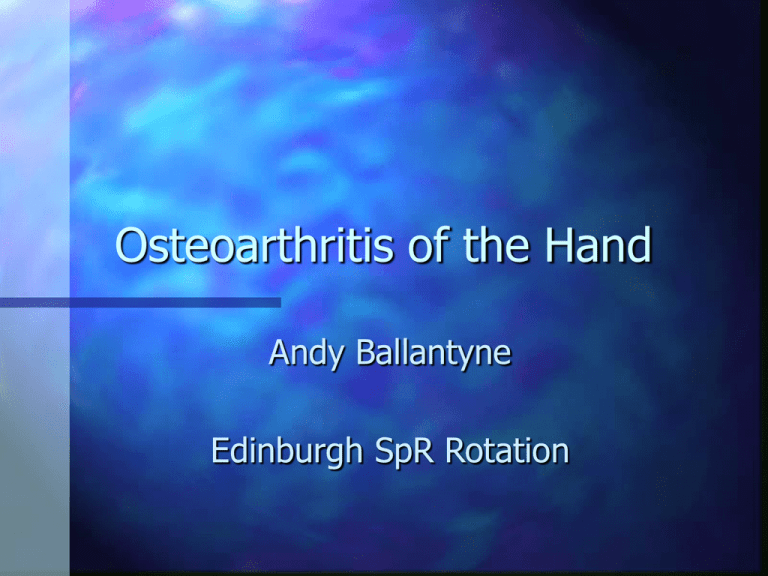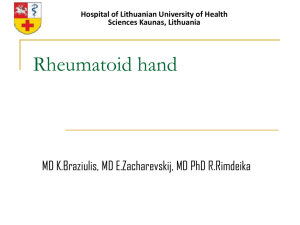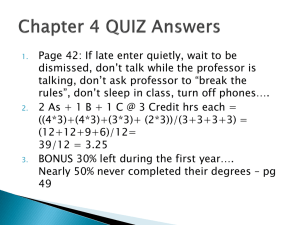
Osteoarthritis of the Hand
Andy Ballantyne
Edinburgh SpR Rotation
What is Osteoarthritis?
OA is a disturbance of the normal
balance of degradation and repair of
articular cartilage and subchondral bone
40% Adult Population Affected
10% Require Medical Treatment
1% Disabled
Multifactorial Aetiology
Age
Sex
Genetics
Trauma
Occupation
Race
Incidence of OA of the Hand
Commonest form of OA
<40 yrs - 50 new cases per 1000 personyears at risk
40 - 59 yrs - 65 new cases per 1000 personyears at risk
>60 yrs - 110 new cases per 1000 personyears at risk
(Kallman et al. 1990, Arth Rheum 33,1323 - 1332)
Pattern of Joint Involvement
Framingham OA
Most commonly affected
Study, Boston - 746
joints
subjects, 1967 - 1993
DIPJ
Chingford Study - 1st CMC
967 female subjects
PIPJ
Baltimore
MCPJ
Longitudinal
Study of Ageing 177 male subjects,
serial hand Xrs
Others - Sesamoid,
Trapezial
Scaphoid/trapezoid,
Pisiform-triquetral OA
Pattern of Joint Involvement
Generalised OA of the Hand - clustering of joint
involvement (Chaisson 1997, Framingham Study)
Prevalent OA in one joint increased the incidence risk of
OA in :
other joints in same row
other joints in same ray
OA in DIPJ or PIPJ increased incidence risk of OA in any
other hand joint. Thumb CMC not a strong predictor
of generalised disease
Pattern of Joint Involvement
Polyarticular subset of hand OA (Egger 1995,
Chingford study)
Major determinants of pattern of involvement
symmetry
clustering by row
clustering by ray
Clinical Features
Fingers
Swelling around joints
Lateral deformity
Osteophytes/exostoses Heberdens Nodes -” little
hard knobs the size of a small
pea, particularily a little below
the top, near the joint”
(Heberden 1710-1801)
Bouchards Nodes
Mallet Finger
Mucous Cysts/Ganglion hyaluronic acid filled cysts
Clinical Features
Thumb CMC
Subluxation of the
CMC - metacarpal base
prominence
Z-deformity - bony
collapse at the MC base
leads to adduction of
the MC and
hyperextension of the
MCP
Examination
Thumb CMC
PIPJ/DIPJ
Tenderness at joint line
Lateral Instability
Pain on Axial Compression
Crepitus on Axial
Compression
Reduced Range of Movement
Tenderness over 1stCMC
Pain and Crepitus on Axial
Compression - torque test
Decreased Pinch Strength
Subluxation - intermittent
pressure to MC base while pat
pinches
Sesamoid Arthritis
Pain palmar plate at thumb
MCP
Good joint space
Elicited by press. on palmar
plate
Radiological Features
88% Joint Space
Narrowing
81% Osteophytes
46% Subchondral
Sclerosis
33% Bony Cysts
<20% Lateral Joint
Deformity
<20% Cortical Collapse
(Kallman 1989, Arth Rheum
32, 1584-1591)
Radiological Classification
Kellgren and Lawrence Scale (1957) Ann
Rheum Dis 16:494 - 501
Kallman (1989) Arth Rheum 32:1584 1591
Dell (1978) - 1st CMC OA
Kellgren/Lawrence Scale
(1957)
0
No Osteophytes
1
Doubtful osteophytes
2
Minimal osteophytes, possibly with
narrowing,cysts and sclerosis
3
Moderate or definite osteophytes with
moderate joint space narrowing
4
Severe with large osteophytes and definite
joint space narrowing
Kallman (1989)
Osteophytes
0 = none
1 = small
2 = moderate
3 = large
Joint space narrowing
0 = none
1 = definitely narrowed
2 = severely narrowed
3 = joint fusion
Subchondral sclerosis
0 = absent
1 = present
Subchondral cysts
0 = absent
1 = present
Lateral deformity
0 = absent
1 = present
Collapse of Central joint Cortical
Bone
0 = absent
1 = present
Dell (1978)
Stage I
Stage II
Mild joint narrowing or subchondral sclerosis. Mild
joint effusion or ligament laxity. No subluxation or
osteophyte formation
Narrowing the CMC and sclerosis. Ulnar osteophytes.
Subluxation radially and dorsally
Stage III
Further narrowing, cystic change and sclerosis. Passive
reduction of subluxation not possible. Scaphotrapezial
joint may show arthrosis
Stage IV
As above, more severe. CMC may be immobile and
pain free
Treatment Options for
OA of the Hand
Non surgical
Splints
NSAIDs
Intraarticular
Injections
Surgical
Stabilisation
Arthrodesis
Arthroplasty
Surgery for Hand OA
1st CMC
DIPJ
PIPJ
MCPJ
other procedures
Surgery for the 1st CMC
Anatomical considerations
Palmar/Ulnar collateral ligament
Dorsal intermetacarpal ligament
Laxity leads to subluxation
Congenital laxity - Ehlos Danlos early OA
changes
Surgery for the 1st CMC
Radiological Considerations
Involvement of other
trapezial joints
86% 2nd metacarpal
48% scaphoid
35% trapezoid
Pattern of joint
involvement influences
choice of procedure
Indications for Surgical
Intervention
Failure of non-surgical methods
pain
instability - weakness in grip
In the presence of OA change Keelgren/Lawrence >2
Arthrodesis of the 1st CMC
Disease limited to
CMC
positioned 45o
palmar and radial
abduction
cup and cone
arthrodesis - 2-5%
non-union
Arthroplasty of the 1st CMC
Trapezium excision
arthroplasty
?fascia/tendon interposition
?ligament reconstruction
??silicone interposition
arthroplasty
Total Joint Arthro.
Hemiarthroplasty
Soft Tissue interposition or
Ligament Reconstruction?
Burton & Pellegrini, 1986 (J Hand Surg) - Lig.
recon and tendon interposition - improved grip
strength and endurance
Gerwin 1997 (Clin Orthop) -lig. recon. no
tendon interposition - no requirement for tendon
interposition
Livesey 1996 (J Hand Surg) - lig. recon.
produces stronger hand than trapezial excision alone,
although slower recovery
Surgery for the DIPJ
Indications
Pain
Instability
Mucous Cyst
Deformity
Options
~80% presenting are at a
stage requiring surgery
to alleviate symptoms
Arthrodesis
Arthroplasty
Procedures for
Symptom Relief
Arthrodesis of the DIPJ
only treatment in the
presence of significant
bone destruction and
instability
multiple methods to
obtain arthrodesis - cup
and cone, K-wires
2% pseudoarthrosis
(Carroll 1969, JBJS - 635
joints)
Surgery for the DIPJ
Interposition
Arthroplasty
silicone interposition preserves motion and
stability
falling into disfavour
Wilgis 1997 (Clin
Orthop) - 38 digits,
<10% implants
removed
Synovectomy and
osteophytectomy stable joint with
good bone
preservation
Mucous Cyst
Excision
Surgery for the PIPJ
Indications
Pain
Instability
Deformity
In the presence of OA
Arthrodesis
Arthroplasty
cemented
silicone interposition
Pelligrini 1990, J Hand Surg - 24
pat
Cemented Biomeric - failed
average 2.25yrs
Silicone - 35% showed bone
resorption
Arthrodesis - greatest
improvement in lat grip
MCP/IPJ Thumb
Arthrodesis - either
IPJ or MCP
Interpositional
Arthroplasty - MCP
Cemented Steffee prosthesis
-slotted component
Swanson Silicone Rubber
Arthroplasty
Soft Tissue Arthroplasty salvage procedures
Surgical Procedures for
Other Joints
MCPJ
Soft tissue Arthroplasty
Joint Replacement Arth.
Steffee Prosthesis
Ball and Socket joints
Sesamoid OA
excision of the
sesamoid
Pisotriquetral OA
injection
pisiform excision
Summary of Surgical
Treatment
1st CMC - Trapezial excisional arthro.
DIPJ - Arthrodesis
PIPJ - unresolved
DIPJ - ?Silicone Interpositional
Arthroplasty
Hand Osteoarthritis
Common problem affecting elderly females
Most commonly affects DIPJ & 1st CMC
Surgical Intervention for pain and instability
Number of unresolved questions regarding
surgical treatment - i.e.. Type of arthroplasty
Outcome - painfree but with reduced ROM
and decreased pinch strength




